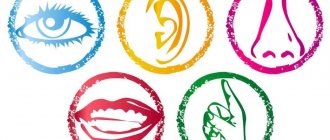Updated July 23, 2021 351 Author: Dmitry Petrov
Hello, dear readers of the KtoNaNovenkogo.ru blog. Creativity has become a fashion statement.
This concept is used as a personal characteristic, people are proud of it and justify any actions, and it is also an item in many resumes.
There is a strong belief that today we cannot do without it, but knowledge here is limited to the vague “something related to creativity.”
Let's find out what creativity is and how to use this word correctly so as not to make a mistake.
What is creativity?
Let's figure out what a creative person means. Creativity is a special personal quality that allows you to effectively engage in creative, creative, innovative activities.
Creative people are those who are able to find new and optimal ways to solve problems. They can see a problem from different angles, sometimes seeing it in a way that no one has seen before. However, creativity is not only innovation and creativity, it is a constructive way of thinking that brings practical benefits in various activities.
About the perception of difficulties
If we list all the qualities of a creative person, this is perhaps the most surprising. In a difficult life situation, they are immersed in creativity, the pain seems to come out of them through what they create.
For example, the famous artist Frida Kahlo began her creative journey when, at a very young age, she was in a car accident and her body was completely in plaster. To somehow entertain herself, she began painting plaster, and later created world-famous masterpieces.
For a creative person, trauma becomes an extraordinary motivating force. In an effort to get rid of suffering, poets and artists look at the situation from the other side and amaze society with the greatest works of art.
What is the difference between creativity and creativity?
Very often people confuse these concepts or use them as synonyms, without thinking about the true meanings of the words. Creativity is also the ability to create new things. However, the concept of creativity refers to art and aesthetic creation, and creativity refers to the area of utilitarian, practical application. These two properties of the human personality can intersect, but do not have to be combined and do not stem from one another.
Modern professions, especially those related to innovation, require creativity - the ability, based on accumulated experience and knowledge, to generate new ideas and methods that optimize the work process or create a unique product. The concept of creativity includes such qualities as determination, the ability to take risks, intelligence, resourcefulness, and quickness of thought. Also, creativity is always accompanied by a broad outlook, because without one, it is difficult to come up with a new solution to a problem.
Substitution of concepts
The word “creativity”, together with its cognates “relatives” (creative, etc.), is often used inappropriately, so it has acquired other meanings, in particular, it has become synonymous with absurdity and absurdity .
This is an unfounded substitution. For example, a person who wears strange-looking clothes may be driven by a desire for originality, a lack of taste or a sense of proportion, but certainly not by creativity.
This concept is used to justify erroneous decisions, actions, and actions. An unsuccessful haircut, a poorly tailored suit, an incorrectly executed document is a reason to hear: “ Nothing, but creative !”
There is also an ironic subtext. For example, a colleague hung a poster with strange content over his desk. What can I say about this? - “Creative!” Wanting to emphasize the “modesty” of the results of the creative process, they say: created .
Professions for creative people
Creative thinking is needed in many fields, including business, advertising, science, art and politics. Nowadays, in many job offers you can find a message that the employer is looking for creative people for various positions.
Creativity in business is the ability to adapt to new management styles and change in accordance with changing market conditions. Business, especially small or medium-sized ones, does not tolerate conservatism. Nowadays, the development of business technologies is proceeding very quickly, new advanced training courses, new trends in personnel management, and so on are constantly appearing. Creativity in business is needed for mobility, speed of decision-making and innovation.
Creativity in advertising is the ability to present a product in a new way, from an unexpected angle. In the modern world, a person receives an overwhelming amount of information per day. Advertising specialists no longer know how to attract the attention of a potential consumer without causing irritation in an overly intrusive or flashy way. It is to solve such problems that creative people are needed in advertising. The advertising message must be of high quality, interesting and informative.
Creativity in the service sector is the ability to find new approaches in communicating with people. This area of application of creativity requires not only a good knowledge of people in the everyday sense and developed intuition, but also an accumulated store of knowledge in the field of psychology and sociology. For the sales sector, it is important to be able to present a product in such a way that a potential buyer wants to purchase it; in the hotel business, the design of rooms or, for example, features of guest service can be creative.
Creativity will find a place in almost any profession if it is subordinated to purely utilitarian goals and not confused with creativity. Most often, creative people are those who, in addition to a developed imagination, have knowledge in the field of economics, management, production technology, and so on.
Creative in the professional sphere
Highly valued in many professions, creativity has considerable practical significance. Photographer, marketer, designer, event organizer, SMM manager - the list of specialties that require creative individuals can be continued for a long time.
There are calculations showing that in the near future up to 60% of professions will become unclaimed - people will be replaced by robots. Only those areas where creative thinking is required cannot be replaced by artificial intelligence.
The staff of advertising agencies, design studios and other similar places often has a “profile” position - creative director. He leads art groups, generates ideas, and is responsible for the final creative product.
Creativity has become a “stamp” on the resumes of a variety of professions, from general director to manager. What do employers mean by this quality, and how to avoid mistakes when filling out this column?
- The main thing is not to overdo it, relying only on creativity. Practice shows that most employers view this quality with a grain of salt. For example, a brand manager is, first of all, a person who masters brand promotion technologies, and only then a creative person.
- A statement about the ability to think outside the box must be supported by real creative achievements (as an option, use a self-invented slogan or logo as an example).
- It is preferable to decipher the concept indicating specific skills and abilities. “I can develop an unconventional product positioning strategy” - this phrase will convince a potential employer that he has a good employee in front of him and should hire him.
Not every position requires creativity from the person filling it. A creative accountant will most likely not please the employer.
Ways to develop creativity
What does the word creative person mean? Creativity is not an innate ability. Yes, there must be prerequisites for it, but it can and should be developed. There are various methods for developing creativity in children and adults. In childhood, attention is paid more to the development of creative abilities and skills, on the basis of which, in combination with acquired experience and knowledge, creativity can subsequently be developed.
Let's look at several exercises to develop this ability.
- Discussing an idea in a team where everyone has a specific role: critic, dreamer and realist. Considering a problem from three points of view allows you to see its new facets and solutions.
- Creating a tree of associations. A problem is depicted on a piece of paper, with lines running from it where ideas related to it are written. In the process of creating a tree, ideas may arise that would not immediately come to mind.
- Take the opposite route. Imagine what needs to be done to ensure that the problem is not solved, and then replace these ideas with the opposite ones.
- It is recommended to expand your horizons - to be interested in everything that happens around you. Go to theatres, visit exhibitions, read newspapers, journalism and communicate more often with creative people, they have something to tell.
This is not a complete list of exercises for developing creativity, but they are all related to expanding the horizons of thinking, developing imagination and destroying stereotypes.
Part 3. What books to read
I'll be brief here. The Internet is full of reviews and reviews of these books. Some I have already read and are actively implementing techniques from there, others are waiting for their turn.
Vasily Lebedev. CRAFT Michael Micalko. Rice Assault Michael Micalko. Hacking creativity Edward de Bono. Genius Heinrich Altshuller. Find an idea by Mark Levy. Genius to order Dave Gray. Liminal Thinking Julia Cameron. The Artist's Path Gareth Moore. Lateral logic
Read books, practice techniques and use them to create creative solutions.
I hope this article has lifted the veil of secrecy over the concept of “creative thinking”. In my Telegram channel I write about training, development of cognitive functions and working with information. I will be glad to see all interested people.
The most creative people
With the growing interest in the term “creativity” in the last decade, printed publications related to this concept began to appear. Many countries publish their own magazines about creativity. Editors of publishing houses compile lists of the most creative people of the past year. These include owners and founders of advertising agencies, software developers, directors, designers, writers, entrepreneurs, singers and journalists.
According to Creativity magazine, the most creative person is Sachin Agarwal, founder of the website Posterous. Along with him, his colleague Jerry Tan was also named the most creative person.
Algorithm for creating advertising creative
In order for advertising to resonate with the audience, you need to take into account factors such as their interests, motivation, involvement, and product benefits. For each factor, you can choose your own selection method.
The Rossiter-Percy purchasing decision matrix will help assess the motivation and involvement of the audience. According to this matrix, a buyer has two types of purchase motivations:
- Positive. Associated with the desire to enjoy the purchase of a product. For example, flowers, food, a new phone.
- Negative. It occurs when a person is looking for a product that will solve his problem: the services of a lawyer or a headache pill.
You need to determine which part of the table a product belongs to and create creatives for advertising that match the motivation of the audience.
Determining the target audience
Segmentation will help assess the target audience: people are divided into segments and behavioral patterns, concerns, even the language and phrases they use are identified. You can collect information about who is interested in your product using social networks, but if the company is young, then live communication will help: conduct interviews with clients, sales department and just acquaintances. Questions must be open-ended, otherwise the result will be too vague.
When determining the target audience, use a list of parameters. They take into account age, gender, income, education, marital status, and hobbies. If it becomes clear who to target, then you can continue working only with this segment.
Identifying Product Benefits
It’s worth making a detailed list of advantages in order to understand what to rely on when creating creativity. Describe them in short abstracts, make a numbered list. It will be convenient to read reviews from those who have used the product and find out what was useful.
Formulation of the advertising idea
A complete image of a product will only be achieved when all stages of an advertising campaign are united by an idea and a common positioning. The idea is better reflected in the slogan, this will help create a unified image of the product. It is also useful to familiarize yourself with the experience of competitors; it can serve as the basis for a successful solution.
Advertising creation
When all the stages have been completed - the place the product occupies in the Rossiter-Percy table, the target audience has been determined, the product's advantages have been found - you can begin to create advertising creatives. Rely on strengths when writing copy and production techniques when looking for creative solutions. Don't neglect visual content.
Signs of a creative person
And yet, what does a creative person mean? Like all internal human qualities, creativity has an external manifestation in behavior.
By what signs can such a person be distinguished from the crowd?
- Creative people are brave people. They are not afraid to try new things.
- Intuition is no less important a decision-making tool for them than logic.
- Creative people have a great sense of humor.
- Creative people are those who share their thoughts and ideas with others.
- They easily understand the most intricate interweaving of information. Creative people subject the information received to critical reflection and never follow the crowd's lead.
- They are interested in the process itself, and not just the result.
- They love to learn new things and look for answers to the most difficult questions. The more difficult the task, the more willingly a creative, creative person will take on it.
- Creative people are always in search of: solutions, answers, knowledge and ideas.
- Creative people are excellent teachers. They easily explain things that are difficult to understand to others, trace connections between existing material and create new things from it.
- A creative person does not tolerate boundaries or boundaries. He constantly expands his horizons, tries on new points of view.
- Creative people are innovators. They are interested in testing new ideas and find themselves competitive in the future.
Attention to detail
Another distinctive feature of creative people is observation. A creative person is open to new experiences; he does not look at life as a series of repeating events. This quality makes these people similar to children. However, they are not just surprised by their observations, but try to record them. Representatives of creative professions often record unusual and funny situations, keep photo and video diaries, and subsequently use this material for speeches, articles, and blogs.
Fashion for creativity
Currently, every second resume in the “additional information” column indicates a quality – creativity. What is a creative person? Is it so important to be creative? Yes, many specialties require making innovative decisions, the ability to think outside the box and present oneself or a product in a non-trivial way. But at the same time, there are enough specialties that do not require a creative approach. In everyday life, the meaning of this feature is even more blurred. With the fashion for creativity, many people want to appear creative and inventive even when communicating with their friends.
A non-creative person is not a person without imagination, unable to think beyond stereotyped constructions. Creativity is, rather, an integral quality for some areas of professional activity, rather than vitally necessary in everyday life. A person does not have to be creative, but it is useful to develop creative abilities at any age.
What is the creative class and does it exist in Russia?
The creative class in Europe and America is usually called people who design and create new ideas, images, and products. These are designers, advertising specialists, marketers, and so on. The global task of the so-called creative class is to change the world, make it more convenient and adapt it to the needs of the population. In a less global sense - to give an attractive appearance to products, introduce any innovations related to everyday comfort, add functionality to household items and equipment. In Russia there is no creative class as such. Here these people are in the minority, since society currently needs creative developments less than European or American ones. This is due to the peculiarities of culture and mentality. However, we can say for sure that the creative direction of activity in Russia is developing. New niches are being found and created in the service market where creative specialists are required. It is difficult to predict whether Russia will catch up with Europe in this sense, but there is no doubt that the creative class will develop in Russia as well.
How to develop creativity: tips and exercises
I offer you simple tips and exercises that will help you develop creativity and move to a new level of perception of reality.
Be adventurous
I’m not talking about the kind of excitement that forces a person to spend all his money in a casino. We are talking about positive excitement, which helps to treat life as an exciting quest. A person with this type of passion perceives life with interest and curiosity, accepts all its challenges, and does not give in to obstacles. For him, any problem is an opportunity to test his strength.
You need to love the process of finding solutions to problems and find the beauty in it. Do not become despondent from hopelessness, but experience drive and pleasant excitement from the opportunity to take on a challenge. It is this attitude that will help unleash your creativity, which will grow from every meeting with problems.
Tame your inner critic
The inner critic is the main killer of original, non-standard ideas, coupled with laziness and procrastination. If you want to develop creativity, you need to learn to turn it off, or at least make it less restrictive.
Remember: any new idea may seem absurd at first. This is how our brain works! He is an incorrigible conservative. He always tries to follow the path of least resistance and save energy and time.
At first, just ignore his grumpy grumbling at your every attempt to do something non-standard. Over time, the brain will be convinced that your ideas are not so bad and have a right to life, and it will grumble much less.
Look for multiple ways to solve problems
Never limit yourself to a single solution to problems, but try to find at least 2-3. This advice applies not only to some intellectual tasks, but also to everyday everyday ones.
For example, you need to arrange the furniture in the room so that it is comfortable and aesthetically pleasing. Even when you find the ideal option, from your point of view, do not rush to implement it. Try to come up with a few more so you have more to choose from.
This habit will be an excellent springboard for the development of creativity. Each time the decisions will be more adequate and thoughtful. Your brain will free itself from the shackles of criticality, and you will begin to trust it more.
Look for the unusual in ordinary things
Learn to always look at the world with fresh eyes. It's like you're a little kid and you're just getting to know him. Notice details that were previously hidden from your view, look behind the screen of familiar things and look for little secrets in them that few people know about.
Don't let routine consume you and turn you into a robot. Take your eyes off the screen right now and look around you. Stop your gaze on a specific object and carefully examine it. What interesting things can you say about him? Maybe it has an unusual fancy shape or an interesting color? Or does it remind you of some exotic animal? Show sincere interest and a little imagination - you will definitely find something that catches your eye.
Expand your horizons
It is very useful to fill the brain with new information. Knowledge is a kind of food for creativity. To make something qualitatively new, you need to have the necessary material. No matter how revolutionary the ideas and solutions may be, they are based on previously accumulated experience, which must be taken into account.
So start being interested in something new. This may be information directly related to your field of activity, or it may simply be knowledge that interests you. Read books, watch educational programs, communicate with smart, erudite people. Fill your intellectual vessel with knowledge, and after a while it will begin to gush with new ideas.
Exercise “Favorite Song”
Each of us has a favorite song or melody. Your task is to remember it and describe it. Only the description should not be quite ordinary. At first, try to use only visual images. What color is your favorite song? If several colors are intertwined in it, try to recreate the entire picture. Think about what it looks like. Maybe to a cold mountain landscape covered in snow? Or a still life of dry autumn leaves, imbued with nostalgia for summer?
When you have a clear and vivid visual picture, add kinesthetic sensations. How does your favorite song feel on your skin? Like salty sea drops flowing down? Or like an icy wind that penetrates to the bones? Or maybe like the soft touch of your favorite cat’s fluffy tail?
Turn on your imagination to the maximum and enjoy a cocktail of feelings.
Exercise “Screenwriter”
Start watching a movie that you haven't watched before. When you reach the halfway point, stop the broadcast and try to come up with several options for developing the plot. Think about what will happen to the characters, whether the ending will be happy or sad.
I offer you a small cheat sheet of what options you can use. So, come up with:
- the most realistic plot;
- funny plot;
- tragic plot;
- plot in the style of a horror film;
- the most absurd and meaningless plot.
And then watch the film and compare your options with the original.
Exercise “Incomprehensible photographs”
Type the phrase “obscure photos” into a search engine and select a few of the strangest images. Try to come up with a logical and plausible explanation for what you see in the picture. It's good if you have several options.
Exercise “Rewind”
Learn to build logical chains not only in the forward direction, but also in the reverse direction. For example, you are dealing with a specific situation. Think about what events, moves and actions could lead to it.
You can use a chessboard for training. Arrange the pieces in a chaotic order, and then try to “rewind” the game back and imagine what moves could lead to this arrangement.
You can also use the pictures from the previous exercise and practice with them.
Exercise “Abbreviations”
Write down a few words of 3-5 letters. Now imagine that these are abbreviations for which you need to find a decoding. Here are some examples:
- NOS – scientifically based advice;
- BOX – fighting squad of red gophers;
- HALL – notes from an anonymous lecturer.
Exercise “Defocusing”
Creative thinking does not tolerate any violence or coercion. This area is closely associated with spontaneity and inspiration, so direct methods of influencing it do not work. It happens that you need to come up with a creative idea here and now, but the brain, as luck would have it, resists. In this case, you cannot put pressure on him, but, on the contrary, you need to try to let him go.
How it's done? Take a comfortable, relaxed position and begin to perceive signals from all your senses at the same time. Listen to the sounds, smell the smells, look around. The brain will try to focus on one modality of sensations - do not give it this opportunity.
After some time, he will become unfocused and reach a state close to trance. Your task is to stay in it for as long as possible. At this moment, a window into the unconscious opens - a real treasure trove of original revolutionary ideas.
Find even more exercises for developing creative thinking on our blog.
What is creativity for?
This quality is used in various fields to solve different problems. In general, creativity is needed to optimize, improve, increase efficiency, increase functionality and production capacity. In a word – for a qualitative leap forward. In science and production, creativity is needed to invent new equipment, new technology, even production technologies themselves. Creativity makes our life more interesting, colorful and comfortable. The transition from an industrial society to a post-industrial one was marked by the expansion of the service sector. Currently, the ability to present a service or product to a potential consumer plays an important role in this area.
Beauty, energy and novelty combined with practical use - this is the creativity that, in practical application, gives aesthetic pleasure and everyday comfort.










